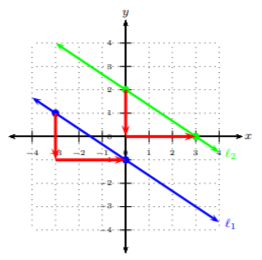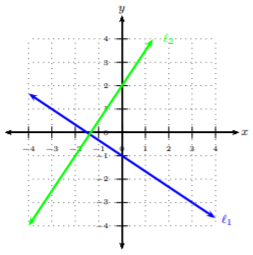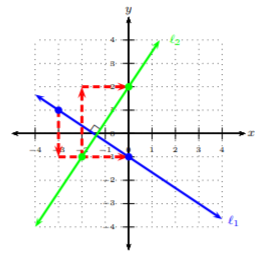2.3: Parallel and perpendicular lines
( \newcommand{\kernel}{\mathrm{null}\,}\)
In this section, we discuss parallel and perpendicular lines. The relationship between parallel lines and between perpendicular lines is unique, where the slope will be most interesting to us in this section.
The Slope of Parallel and Perpendicular Lines
Find the slope of each line and compare. What is interesting about the slopes?

Solution
Looking at ℓ1, we can start at (−3,1) and reach the next point at (0,−1). We see that we will move down two units and run to the right 3 units. Hence, ℓ1’s slope is −23. Now let’s look at ℓ2 and obtain its slope. We will start at (0,2) and reach the next point at (3,0). We see that we will move down two units and run to the right 3 units. Hence, ℓ2’s slope is −23. The slopes of ℓ1 and ℓ2 are −23; they have the same exact slope but different y-intercepts.

Let m1 and m2 be slopes for lines ℓ1 and ℓ2, respectively. Lines ℓ1 and ℓ2 are parallel to each other if they have the same slope, but different y-intercepts, i.e., m1=m2.
Find the slope of each line and compare. What is interesting about the slopes?

Solution
Looking at ℓ1, we can start at (−3,1) and reach the next point at (0,−1). We see that we will move down two units and run to the right 3 units. Hence, ℓ1’s slope is −23. Now let’s look at ℓ2 and obtain its slope. We will start at (−2,−1) and reach the next point at (0,2). We see that we will move up three units and run to the right 2 units. Hence, ℓ2’s slope is 32. The slopes of ℓ1 and ℓ2 are negative reciprocals, i.e., if one has slope m, then a line perpendicular to it will have slope −1m. Also, note that if two lines are perpendicular, they create a right angle at the intersection.

Let m1 and m2 be slopes for lines ℓ1 and ℓ2, respectively. Lines ℓ1 and ℓ2 are perpendicular to each other if they have negative reciprocal slopes, i.e., ℓ1 has slope m1 and ℓ2 has slope m2=−1m1.
Find the slope of a line parallel to 5y−2x=7.
Solution
We need to rewrite the equation in slope-intercept form. Then we can identify the slope and the slope for a line parallel to it.
5y−2x=7Isolate the variable term 5y5y−2x+2x=7+2xSimplify5y=2x+7Multiply by the reciprocal of 515⋅5y=15⋅2x+7⋅15Simplifyy=25x+75
We see the slope of the given line is 25. By the definition, a line parallel will have the same slope 25.
Find the slope of a line perpendicular to 3x−4y=2.
Solution
We need to rewrite the equation in slope-intercept form. Then we can identify the slope and the slope for a line perpendicular to it.
3x−4y=2Isolate the variable term −4y3x−4y+(−3x)=2+(−3x)Simplify−4y=−3x+2Multiply by the reciprocal of −4−14⋅−4y=−14⋅−3x+2⋅−14Simplifyy=34x−12
We see the slope of the given line is 34. By the definition, a line perpendicular will have a negative reciprocal slope −43.
Obtain Equations for Parallel and Perpendicular Lines
Once we have obtained the slope for a line perpendicular or parallel, it is possible to find the complete equation of the second line if we are given a point on the second line.
Find the equation of a line passing through (4,−5) and parallel to 2x−3y=6.
Solution
First, we can rewrite the given line in slope-intercept form to obtain the slope for a line parallel to it: 2x−3y=6Isolate the variable term −3y2x−3y+(−2x)=6+(−2x)Simplify−3y=−2x+6Multiply by the reciprocal of −3−13⋅−3y=−13⋅−2x+6⋅−13Simplifyy=23x−2
We see the slope of the given line is 23. By the definition, a line parallel will have the same slope 23. Next, we can use the point-slope formula to obtain the equation of the line passing through (4,−5) with slope 23: y−y1=m(x−x1)Substitute in the point and slopey−(−5)=23(x−4)Simplify signsy+5=23(x−4)A line parallel to 2x−3y=6 in point-slope form
Find the equation of the line, in slope-intercept form, passing through (6,−9) and perpendicular to y=−35x+4.
Solution
Since the given line is in slope-intercept form, we can easily observe the slope and the slope for a line perpendicular. We see the slope of the given line is −35. By the definition, a line perpendicular will have a negative reciprocal slope 53. Next, we can use the point-slope formula to obtain the equation, in slope-intercept form, of the line passing through (6,−9) with slope 53: y−y1=m(x−x1)Substitute in the point and slopey−(−9)=53(x−6)Simplify signsy+9=53(x−6)Distributey+9=53x−10Isolate the variable term yy+9+(−9)=53x−10+(−9)Simplifyy=53x−19A line perpendicular to y=−35x+4 in slope-intercept form
Lines with zero slopes and undefined slopes may seem like opposites because a horizontal line has slope zero and a vertical line has slope that is undefined. Since a horizontal line is perpendicular to a vertical line, we can say, by definition, the slopes are negative reciprocals, i.e., m1=0 would imply m2=−10, which is undefined.
Find the equation of the line passing through (3,4) and perpendicular to x=−2.
Solution
Since x=−2 is a vertical line, then this line has slope that is undefined. Hence, a line perpendicular to it will have slope zero, i.e., m=0. Next, we can use the point-slope formula to obtain the equation, in slope-intercept form, of the line passing through (3,4) with slope m=0: y−y1=m(x−x1)Substitute in the point and slopey−4=0(x−3)Distributey−4=0Isolate the variable term yy−4+4=0+4Simplifyy=4A line perpendicular to x=−2
Now, since we are aware that a line perpendicular to a vertical line is a horizontal line and we were given a point (3,4), we could have easily jumped to the equation, y=4.
Parallel and Perpendicular Lines Homework
Given the line, find the slope of a line parallel.
y=2x+4
y=4x−5
x−y=4
7x+y=−2
y=−23x+5
y=−103x−5
6x−5y=20
3x+4y=−8
Given the line, find the slope of a line perpendicular.
x=3
y=−13x
x−3y=−6
x+2y=8
y=−12x−1
y=45x
3x−y=−3
8x−3y=−9
Find the equation of the line, in point-slope form, passing through the point and given the line to be parallel or perpendicular.
(2,5); parallel to x=0
(5,2); parallel to y=75x+4
(3,4); parallel to y=92x−5
(1,−1); parallel to y=−34x+3
(2,3); parallel to y=75x+4
(−1,3); parallel to y=−3x−1
(4,2); parallel to x=0
(1,4); parallel to y=75x+2
(1,−5); perpendicular to −x+y=1
(1,−2); perpendicular to −x+2y=2
(5,2); perpendicular to 5x+y=−3
(1,3); perpendicular to −x+y=1
(4,2); perpendicular to −4x+y=0
(−3,−5); perpendicular to 3x+7y=0
(2,−2); perpendicular to 3y−x=0
(−2,5); perpendicular to y−2x=0
Find the equation of the line, in slope-intercept form, passing through the point and given the line to be parallel or perpendicular.
(4,−3); parallel to y=−2x
(−5,2); parallel to y=35x
(−3,1); parallel to y=−43x−1
(−4,0); parallel to y=−54x+4
(−4,−1); parallel to y=−12x+1
(2,3); parallel to y=52x−1
(−2,−1); parallel to y=−12x−2
(−5,−4); parallel to y=35x−2
(4,3); perpendicular to x+y=−1
(−3,−5); perpendicular to x+2y=−4
(5,2); perpendicular to x=0
(5,−1); perpendicular to −5x+2y=10
(−2,5); perpendicular to −x+y=−2
(2,−3); perpendicular to −2x+5y=−10
(4,−3); perpendicular to −x+2y=−6
(−4,1); perpendicular to 4x+3y=−9


